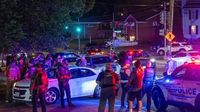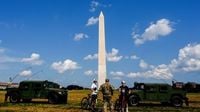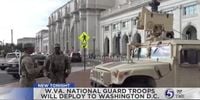On August 11, 2025, President Donald Trump made a sweeping announcement from the White House, flanked by Attorney General Pam Bondi and Secretary of Defense Pete Hegseth. The president invoked Section 740 of the District of Columbia Home Rule Act—Emergency Control of Police—declaring what he called a “historic action to rescue our nation’s capital from crime, bloodshed, bedlam, and squalor, and worse.” According to the president, the federal government would assume control of the Metropolitan Police Department (MPD) and deploy the National Guard to Washington, D.C. for at least 30 days, a move that has sparked heated debate, protests, and legal scrutiny across the city.
“This is liberation day in D.C, and we’re taking our capital back,” Trump declared, as reported by The Hilltop. The White House’s official fact sheet detailed plans to mobilize the District of Columbia National Guard to “address the epidemic of crime in the Nation’s Capital.” Yet, as The Hilltop and Newsweek both noted, the president’s rhetoric seemed to sidestep the reality that violent crime in Washington, D.C. had actually declined—down 26 percent from 2024, with the United States Attorney’s Office reporting a 30-year low in violent offenses last year.
Despite the statistics, the federalization of D.C.’s police force began swiftly. Hundreds of National Guard members started arriving in the capital, joining 800 unarmed troops activated by President Trump the previous week, according to ABC News. On August 18, three Republican-led states offered to send even more National Guard troops to Washington, D.C., reinforcing the federal presence. Department of Homeland Security (DHS) officers began patrolling the U Street corridor, while Drug Enforcement Administration (DEA) agents and other federal officers joined local police on patrols throughout the city. Scenes of District of Columbia National Guard soldiers moving military vehicles at Union Station, patrolling the National Mall, and keeping watch inside Metro stations became commonplace, as captured by Associated Press photographers.
The federal intervention included more than just policing. The president’s plan called for the clearing of homeless encampments, a move he had foreshadowed in an August 10 post on Truth Social: “I’m going to make our Capital safer and more beautiful than it ever was before. The homeless have to move out, IMMEDIATELY. We will give you places to stay, but FAR from the Capital.” By August 14, camping tents near the Lincoln Memorial were being cleared in advance of a city-issued vacate order, with law enforcement and city workers overseeing the process.
For many D.C. residents and leaders, the scope and tone of the federal action were deeply unsettling. Mayor Muriel Bowser, speaking alongside MPD Chief Pamela A. Smith, described the deployment as “unprecedented, but not surprising.” She acknowledged that the Home Rule Act obliges the city to comply with federal requests during a declared emergency, but she did not hide her concern about the city’s lack of autonomy. “My message to residents is this: we know that access to our democracy is tenuous. That’s why you have heard me and many Washingtonians before me advocate for full statehood for the District of Columbia,” Bowser said, as quoted by The Hilltop.
Chief Smith echoed the mayor’s stance, emphasizing her intention to work collaboratively with federal partners. She recounted a conversation with the director of the U.S. Marshal’s Office, in which she stressed the importance of coordinated efforts to reduce crime. “In that conversation, it was very important for me to ensure that not only do we work collaboratively with our federal partners, but we offer up areas across our city where we can work with them in areas where we want to reduce crime,” Smith said.
The federal takeover has not gone unchallenged. Protests erupted almost immediately following the announcement, with demonstrators rallying under the banner of “Free DC”—a movement advocating for the city’s right to self-governance. On August 13, protestors gathered at a federal checkpoint on 14th Street, chanting “get off our streets” at officers. Civil rights groups and social service organizations, including the American Civil Liberties Union of Washington, DC (ACLU DC), issued strong statements condemning the deployment as a “phony justification” for abusing emergency powers. Monica Hopkins, Executive Director of ACLU DC, warned that the president’s actions “foreshadowed that if these heavy-handed tactics take root here, they will be rolled out to other majority-Black and brown cities, like Chicago, Oakland and Baltimore.” Alicia Yass, Supervising Policy Council for ACLU DC, added, “We are seeing that D.C. is just the next step in the president’s plan to attack Black and brown majority cities. We need to recognize that the president is targeting communities that he does not respect or support.”
The DC Appleseed Center for Law and Justice echoed these sentiments, describing the federal intervention as “profoundly undemocratic.” In their view, the presence of the National Guard and federal law enforcement could introduce new dangers, since these forces are not trained for local policing. “This executive action taken today reflects the current administration’s drive for power and control versus a genuine need to improve local safety in the district,” their statement read.
Safety concerns extended beyond the streets. Howard University issued a campus-wide advisory on August 12, urging students and faculty to be vigilant amid the increased presence of federal law enforcement. The university’s Department of Public Safety encouraged the community to avoid risky situations and highlighted available mental health resources, recognizing the anxiety that a militarized city can provoke.
Not everyone agrees with the premise that law enforcement is the only—or even the best—way to ensure public safety. Alicia Yass pointed to alternative programs like the Office of the State Superintendent of Education Child Subsidy Program and the Attorney General’s Restorative Justice Program, which she credits with reducing recidivism and supporting families. “It’s been proven time and time again that building up communities is what makes them safer. Allowing people to have economic security, good education, and pathways to stable jobs are all necessary for building up the community,” Yass said.
As the federal occupation of D.C. continues, the city finds itself at the center of a national debate over the limits of federal power, the meaning of local democracy, and the best path to public safety. With protests, legal challenges, and a heavy law enforcement presence all unfolding at once, Washington, D.C. is living through a moment that will not soon be forgotten.


